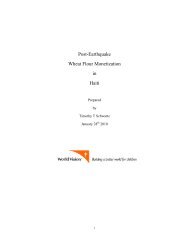Food Consumption Patterns Part 2
Create successful ePaper yourself
Turn your PDF publications into a flip-book with our unique Google optimized e-Paper software.
150<br />
Annex 9: Summary of Results from the Consumer Focus Group Survey<br />
A questionnaire was applied to the 128 participants in the nine Consumer Focus Groups. Many of<br />
the same questions were asked during the 632 respondent random quantitative survey and hence<br />
were not included in the main body of the report. As can be seen here, the responses were almost<br />
identical to those from the larger random survey. The exception is that far more respondents<br />
reported eating peanut butter and peanut products in the morning.<br />
Consumers<br />
All 113 respondents claimed to eat peanut butter. However, 14 refused to taste it and 13 reported<br />
never buying it. From market studies conducted elsewhere, it appears that peanut butter sold on<br />
wheat of cassava bread as a ready to eat street food is essentially free, used as an inducement to<br />
selling the breads. As seen in Table 2, below, this practice is echoed in the fact that the average<br />
expenditure per peanut butter purchase is 100 goud, significantly more peanut butter than a person<br />
can or would eat at one time. In summary, 47% of respondents report buying more than they can<br />
eat, 83% eat it with wheat bread rather than cassava (a trend specific to the Northern Cape Haitian<br />
region); 61% often wants to eat more than they have available, 85% would eat more if it were less<br />
expensive, 56% eats peanut butter more often than peanuts, 88% believes peanut butter is food for<br />
the health and 50% believe that it is better for the health than peanuts; 72% think that adults eat it<br />
as or more often than children. Regarding flavor, 53% prefer salty over sweet. The popularity of<br />
peanut butter and peanuts is illustrated in Figure 7: 61% of respondents eat peanut butter at least<br />
every day and 73% claim to eat peanuts every day. Both peanuts and peanut butter are<br />
overwhelmingly thought of as breakfast foods (see Figure 8).<br />
Median<br />
cost of<br />
peanut<br />
butter<br />
purchase<br />
Buys<br />
more<br />
than<br />
eats<br />
at<br />
once<br />
Eats PB<br />
on<br />
wheat<br />
rather<br />
than<br />
cassava<br />
bread<br />
Table A9-1: Attitudes toward Peanut Butter<br />
Prefers<br />
salty<br />
over<br />
sweet<br />
flavor<br />
Often<br />
wants<br />
to eat<br />
more<br />
than<br />
buys<br />
Would<br />
eat<br />
more<br />
PB if<br />
cheaper<br />
Eats PB<br />
more<br />
often<br />
than<br />
peanuts<br />
Sure<br />
that PB<br />
is good<br />
for the<br />
health<br />
Believes<br />
PB better<br />
for health<br />
than<br />
peanuts<br />
Thinks<br />
that<br />
adults eat<br />
PB as or<br />
more<br />
often than<br />
children<br />
100 gd 47% 83% 53% 61% 85% 56% 88% 50% 72%
















